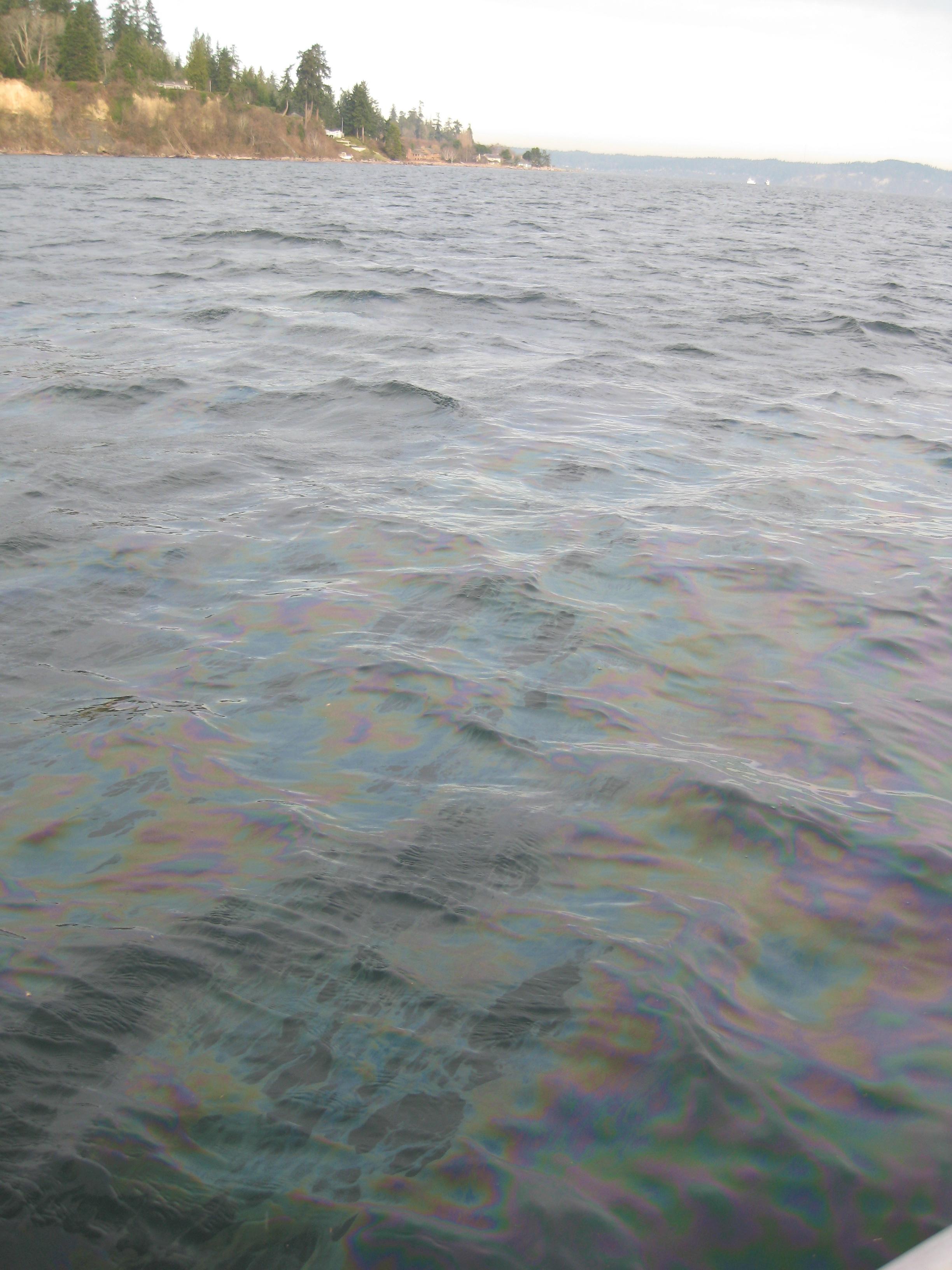Eagle Harbor incident
The state Department of Ecology and the U.S. Coast Guard are responding to an oil spill near Eagle Harbor in Kitsap County.
Summary information
Off Bainbridge Island, Kitsap County, WA

Sheen from an oil spill near Eagle Harbor in Kitsap County.
Status updates
February 4, 2009
An oil spill from an Olympic Tug and Barge tug boat occurred off of Bainbridge Island around midnight last night.
The tug Catherine Quigg was conducting an internal fuel transfer when the spill occurred. The quantity of oil spilled to deck of the tug is unknown.
The initial notification of the spill was for an estimated maximum of 50 gallons to water. Actual spill volume is unknown.
The company has an approved oil spill contingency plan, which they activated. Marine Spill Response Corporation, a contractor for Olympic tug and Barge, has spill response and recovery equipment working at the location
- Ecology spill responders were in the field before daylight. Assessment for potential beach impacts will be conducted this morning. Ecology spill investigators have responded to the scene to begin investigation of the cause.
- Public affairs staff worked to issue a joint press release with U.S. Coast Guard.
- Ecology activated the King County contract to have them fly their helicopter with forward looking infrared capability (FLIR) to the scene during the night.
- Two skimming vessels and associated work boats are working to collect oil and minimize impacts to shorelines.
The King County FLIR capability worked well. A visible sheen about ½ mile long and 100’ wide was spotted approximately 100 to 300 feet off-shore. The spill appears to be small and dissipating.
The Catherine Quigg is a 61 foot tugboat built in 1977. The tug previously spilled about 43 gallons of diesel in 2006. The 2006 spill also occurred during an internal transfer of oil.
Cleanup from an overnight oil spill in Puget Sound wrapped up this morning off Bainbridge Island. The tugboat Catherine Quigg reported the release of an estimated 35 to 50 gallons of diesel fuel into waters northeast of Eagle Harbor, off the island’s eastern shore.
The U.S. Coast Guard and the Washington State Department of Ecology (Ecology) oversaw the spill response. The tug is owned by Olympic Tug and Barge of Seattle.
Four response vessels from Marine Spill Response Corporation – hired by the company – crisscrossed the area with oil-absorbing booms and pads from shortly after 1 a.m. until mid-morning, when no more oil could be recovered from the water.
A 3 a.m. flight by a King County Sheriff’s Office helicopter – under a contract with Ecology – provided infrared images that helped pinpoint the affected waters. The spill covered an area approximately 100 feet wide and one-half to three-quarters of a mile long, north to south, 100 to 300 feet off shore between Skiff Point and Yeomalt Point.
At first light, Ecology and the Washington State Department of Fish and Wildlife searched area shorelines by boat. The inspection – completed by mid-morning – turned up no oil on shore and no effects to wildlife.
Coast Guard and Ecology investigators are working in cooperation with Olympic Tug and Barge to determine the cause of the spill. The oil release occurred while tug crew was transferring fuel between tanks on board the vessel.
Calm, clear weather enabled response efforts to begin during the night. In the absence of foul weather or fog the tug crew promptly detected the spill, and the helicopter could fly and use the infrared equipment.
All oil spills, regardless of size, can affect the marine environment.
February 3, 2009
The state Department of Ecology and the U.S. Coast Guard are responding to an oil spill near Eagle Harbor in Kitsap County.
The spill was reported to Ecology at 11:15 p.m. on Tuesday, February 3, 2009. State and federal authorities have responders and investigators in route to the site to determine the source, type, and location of the spilled oil and to plan cleanup strategies.
Ecology and U.S. Coast Guard are working to:
- Get boats, oil skimming vessels, oil containment boom and other response equipment in the water.
- Investigate potential sources of the spill.
- Conduct aerial over flights to determine the magnitude of the spill and track its location.
- Identify important fish and wildlife habitat areas.
- Observe and respond to potential shoreline and wildlife impacts.

